Lentil crop agronomy; sowing to harvest
Author: Penny Roberts and Sarah Day (SARDI Agronomy Clare), Jenny Davidson (SARDI Plant Pathology), Navneet Aggarwal (SARDI Agronomy Clare), Christine Walela and Larn McMurray (previously with SARDI) and Helena Oakey (The University of Adelaide) | Date: 01 Aug 2019
Take home messages
- Lentil production from sowing to harvest is largely driven by paddock history and variety selection.
- Understanding the agronomic characteristics of lentil varieties will influence the subsequent management of weeds, disease, the opportunity to spray top, and harvest timing.
Background
The adoption of pulse crops in South Australia (SA) has continued to increase over the past 10 years, with pulse crops making up an important part of many farming systems in all rainfall zones of SA. Rapid changes in the industry continue to occur, with the release of herbicide tolerance traits in lentil, a lowering of disease ratings in some lentil varieties, weed management challenges in the lentil phase of the rotation, and the expansion of lentil production to the medium-low rainfall zones of SA. It is important for growers to have access to the best agronomic management strategies for existing and new release varieties in order to maximise the yield potential of pulse crops. The current Southern Pulse Agronomy program has been undertaking field trials in SA and Victoria from 2015-2018 on a range of pulse crops including lentil. The Break Crop Options in Low Rainfall Farming Regions of southern Australia project is focused on identifying the best break crop options and management strategies for different climate, soil type and biotic stress situations within major cropping regions of the southern low rainfall zone. In addition, Improving Weed Management in High Break Crop Intensity Farming Systems is focused on understanding the build-up of resistance in ryegrass and broadleaf weeds in high break crop intensity systems, and to develop effective management strategies including integrated weed management practices for major problematic weeds of break crops. This paper focuses on combining the results of the work being undertaken in these three agronomy research programs to describe aspects of lentil agronomy from sowing to harvest.
Results and discussion
Pre-seeding and seeding
Variety choice
The first choice when selecting a variety is to consider the paddock history and understand the aim of the lentil crop in that season. Increasingly, the use of sulfonylurea (SU) herbicides in the previous cereal crop and the choice of an imidazolinone (IMI) herbicide for in season weed control have become key determinates in variety selection. This limits the variety choice to PBA Hurricane XT and PBA Hallmark XT. Long-term research has demonstrated that these two varieties have the same level of tolerance to SU residuals and in-crop applications of IMI herbicides. However, the two varieties have differing characteristics for seed size, with PBA Hurricane XT being a small red type and PBA Hallmark XT a medium red lentil. They also have different botrytis grey mould ratings with PBA Hallmark XT having an improved rating over PBA Hurricane XT (Table 1).
Where a conventional lentil can be grown there is a yield benefit over the two XT varieties, as seen in long-term research and NVT trials (Figure 1). The grain yield of PBA Jumbo 2 and PBA Flash are consistently above the predicted site mean yield at Yeelanna. PBA Jumbo 2 is the highest yielding red lentil variety across SA, while PBA Flash and PBA Bolt offer improved tolerance to boron and salt (Table 1).
The variety choice will then influence the in-crop herbicide and fungicide decisions for the rest of the season.
Table 1. Characteristics of selected red lentil varieties.
Lodging resistance | Pod drop | Shattering | Botrytis grey mould | Ascochyta blight | Improved tolerance | |||
|---|---|---|---|---|---|---|---|---|
Foliage | Seed | Boron | Salt | |||||
PBA Blitz | MR/MS | MR | MR | MR | MR | MR/MS | ||
PBA Bolt | R | R | R | S | MR | R/MR | Y | Y |
PBA Flash | MR | MR | MR | MR/MS | MS | MS | Y | Y |
PBA Hallmark XT | MR | MR | R | R/MR | MR/MS | MR | ||
PBA Hurricane XT | MR | MR | R | MR/MS | MR/MS | MR | ||
PBA Jumbo 2 | MR/MS | MR | R | R/MR | R | R | ||
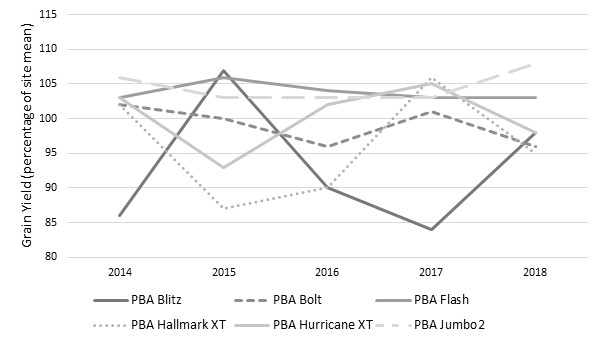
Figure 1. Yield performance of lentil varieties at Yeelana NVT lentil site, 2014-2018. PBA Jumbo 2 and PBA Flash are consistently above the predicted percent of the site mean grain yield (t/ha).
Time of sowing
The grain yield response in lentil to time of sowing is complex, with location and environmental limiting factors impacting yield response. The broad range of agronomic characteristics in commercial lentil varieties compared to other pulses in southern Australia contributes to this complexity. An understanding of the differences in the agronomic characteristics and how they interact with the environment and potential constraints is important when making variety selection. In general, early sowing with the break of the season is beneficial, with the newer varieties better adapted to early sowing than traditional varieties (Figure 2). However, constraints including weeds, disease, high biomass, and frost during reproductive phases will reduce the benefits of early sowing.
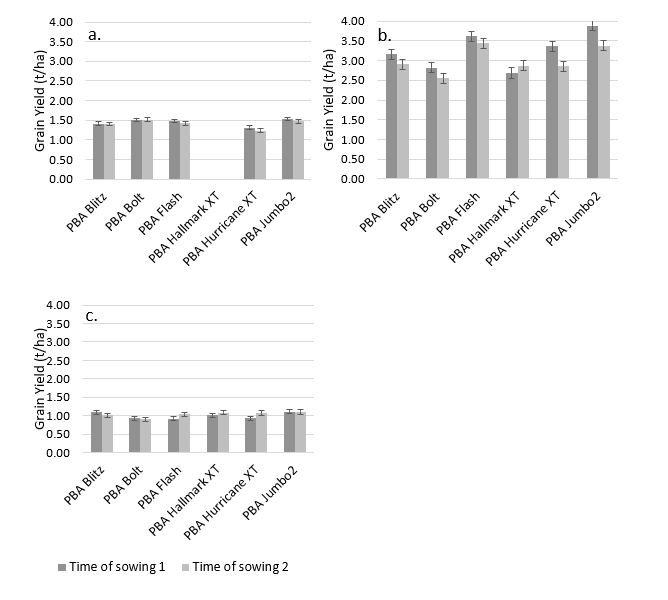
Figure 2. Selected red lentil variety response to two times of sowing, the first time of sowing was driven by the break in the season (generally early May) and the second time of sowing was delayed by 3-4 weeks (late May-early June) in a. 2015, b. 2016 and c. 2017 at Pinery. Error bars represent least significant difference.
Herbicide applications and weed management
Group B herbicide tolerance – PBA Hurricane XT and PBA Hallmark XT
Long-term research comparing PBA Hallmark XT to PBA Hurricane XT showed that both varieties have the same level of response to applied herbicides, but PBA Hallmark XT had higher yield across all herbicides. This work demonstrated a level of tolerance to imazethapyr at label rate when applied post emergence (4-5 node growth stage), and to some sulfonylurea herbicides (SU) applied as simulated low-level residuals from a previous cereal crop (Figure 3). However, it is important to note that yield reductions did occur in response to some sulfonylurea herbicides applied as simulated residuals compared to the nil. A higher yield loss was observed where soils were sandy and low in organic matter content. In all years, chlorsulfuron applied as a simulated residual resulted in yield reductions ranging from 8%-52% compared to the nil. Metsulfuron-methyl and triasulfuron also reduced yields in two out of three years at Pinery, with 13%-18% and 8%-34% yield reductions, respectively.
Importantly, current permits, product label rates, plant back periods and label directions must be adhered to. There is a current permit (PER87042) for use of imazethapyr in PBA Hallmark XT.
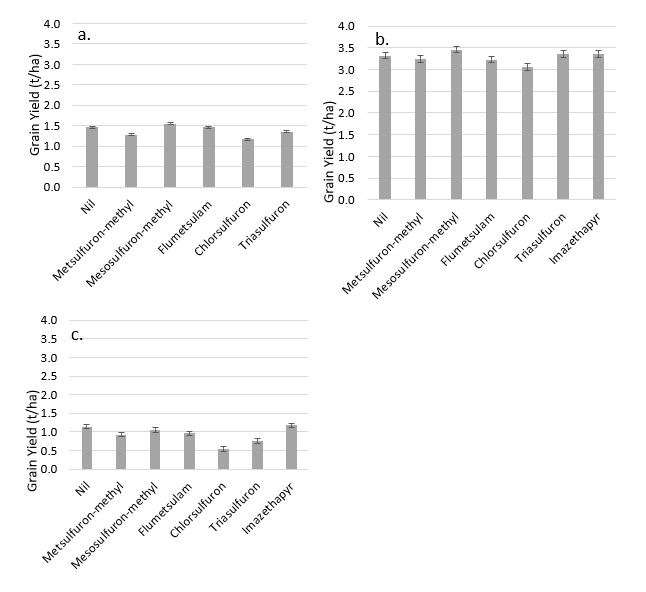
Figure 3. Grain yield (t/ha) response to the application of imazethapyr herbicide applied post emergence (4-5 node growth stage) and sulfonylurea herbicides applied as simulated low-level residuals from a previous cereal crop a. 2015, b. 2016 and c. 2017 at Pinery. Both varieties have the same tolerance pattern to Group B herbicides – mean yield of both is shown. Error bars represent least significant difference.
Herbicide choice and timing of application
Preliminary research is being undertaken at Minnipa to assess the herbicide choice and timing on PBA Hurricane XT lentil. Herbicide choice and application timing is important to reduce risk associated with lentil production in medium to low rainfall environments, particularly as lentil is sensitive to herbicide use in dry conditions. In work undertaken at Minnipa in 2018 Terbuthylazine expressed a lower safety level and higher economic risk than Diuron and Metribuzin, with lentil generally more sensitive to Terbuthylazine than other pulse crops (Figure 4 and 5). The use of Diuron or Metribuzin is lower risk in this environment (Figure 4). If applying herbicide PSPE, economic and production risk is similar for Diuron and Metribuzin and either option is suitable (Figure 5).

Figure 4. Grain yield response of PBA Hurricane XT to combined herbicide and application timing at Minnipa, 2018. Error bars represent least significant difference (0.095 t/ha, P<0.001). Note: IBS = incorporated by sowing, PSPE = post-sowing pre-emergent
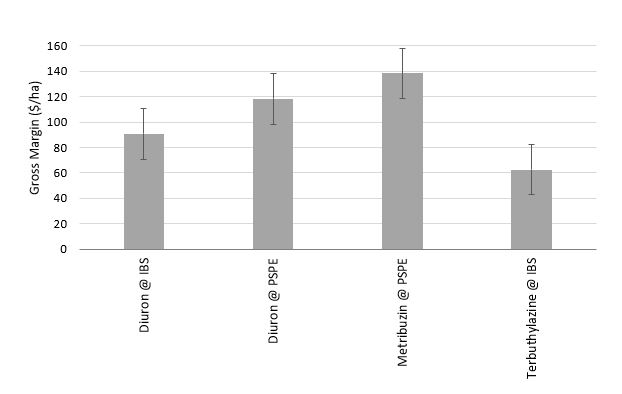
Figure 5. Gross margin response of PBA Hurricane XT to combined herbicide and application timing at Minnipa, 2018. Error bars represent least significant difference ($39.81/ha). IBS = incorporated by sowing, PSPE = post-sowing pre-emergent.
Note: Gross margins represent average case scenarios and should be used as a guide only.
Weed control
Ryegrass
The management of Group A resistant ryegrass (dim-resistant) is a challenge in lentil production. Two research trials were conducted during 2017 at the Hart field site (Mid North) and Maitland (Yorke Peninsula), investigating different pre-emergent herbicides for controlling dim-resistant ryegrass in lentil (PBA Hurricane XT). The use of propyzamide resulted in the lowest ryegrass spike and seed set at both locations, and was similar to Ultro®*, Sakura® and Boxer Gold® (Table 2). Ultro®*(carbetamide, Group E), which is currently in development, provided a 98% reduction in ryegrass seed set over unweeded control at both sites. Additionally, Ultro* produced similar lentil yield to propyzamide, Sakura® and Boxer Gold®. Registration of a Group E herbicide should reduce selection pressure on Group A, D, J and K herbicides.
Table 2. Ryegrass seed heads and seed set at maturity, and lentil yield, at Hart and Maitland in 2017. For each trait, means with different letters are significantly different (P<0.05).
Herbicide | Hart 2017 | Maitland 2017 | ||||
|---|---|---|---|---|---|---|
Head counts (per m2) | RG seed set (per m2) | Yield (t/ha) | Head counts (per m2) | RG seed set (per m2) | Yield (t/ha) | |
Ultro (IBS)* + Clethodim® (POST) | 6.5b | 352b | 1.95b | 4.8b | 269b | 3.62b |
Boxer Gold® (IBS) + Clethodim® (POST) | 9.4b | 440b | 1.98b | 28.1b | 1697b | 3.39b |
Sakura® (IBS) + Clethodim® (POST) | 10.2b | 549b | 2.02b | 9.6b | 585b | 3.85b |
Propyzamide (IBS) + Clethodim (POST) | 4.9b | 120b | 1.8b | 0.5b | 23b | 3.71b |
Control | 203.8a | 15364a | 1.38a | 179.6a | 13595a | 2.66a |
*Recommendation of Ultro use in lentil will be governed by the outcome of its registration application with APVMA.
Bifora
Controlling bifora in PBA Hurricane XT lentil was the focus of a trial established in 2018 at Bute (Yorke Peninsula). The trial included common industry usage practice (chlorsulfuron and Intercept®) for bifora control in lentil and was compared with the registered herbicides (Table 3). Chlorsulfuron (IBS) and Intercept® (POST) resulted in good control of bifora, and imazethapyr (PSPE) provided complete control in these experiments (Table 3). Further, imazethapyr 100 (PSPE) also recorded the highest lentil yield. Application of chlorsulfuron (IBS) + Intercept® (POST) resulted in 17% lentil yield reduction as compared to Imazethapyr (PSPE). Earlier in 2017, chlorsulfuron (IBS) + Intercept® (POST) also recorded lentil yield penalty up to 13% as compared to Imazethapyr (PSPE) (data not shown). Furthermore, the use of chlorsulfuron is also associated with long term residues issues in soils (product label).
Table 3. Management of bifora in PBA Hurricane XT lentil at Bute, 2018.
Treatment | ***Bifora plants/m2 | ***Bifora seeds/m2 | Yield (t/ha) |
|---|---|---|---|
Metribuzin (PSPE) | 23.8b | 66.2a | 0.59b |
Metribuzin (PSPE) + Intercept* (POST) | 7.0 c | 18.8b | 0.84b |
Chlorsulfuron (IBS) + Intercept* (POST) | 3.7cd | 7.9c | 1.26a |
Imazethapyr** (PSPE) | 0d | 0c | 1.52a |
Metribuzin (PSPE) + Imazethapyr** (PSPE) | 0d | 0c | 1.21a |
Unweeded control | 29.3a | 58.7a | 0.68b |
*Use under permit number (PER 87417).
**Use under permit number (PER87042)
***Figures are means after square-root transformation
Disease control
The current fungicide regimes have been developed for the medium-high rainfall zones with the recommendations differing depending on the resistance rating and the disease type. As lentil are increasingly grown in the medium-low rainfall zones work is being done to determine if the recommendations developed for the medium-high rainfall zones are also effective for the medium-low rainfall zones. Initial research data indicates it is likely that some applications can be eliminated, however this will be dependent on individuals’ attitudes to risk and the seasonal conditions.
Ascochyta blight
The current recommendation for lentil in the medium-high rainfall zone is planting with a thiram based seed dressing. For resistant (R) and moderately resistant (MR) varieties crops should be monitored and spray applications undertaken ahead of rain fronts mid-September if ascochyta blight is present, with a second podding spray if it rains, in order to prevent pod infection and seed staining. For moderately susceptible (MS) varieties (PBA Flash) an additional earlier spray (during August) may be required if ascochyta blight is present and numerous rain fronts are forecast.
Initial research results suggest the fungicide regime for ascochyta blight could be different in the medium-low rainfall environments due to less conducive conditions for disease infection and spread. Monitoring the crop for signs of disease and only spraying if disease is detected may work in low risk seasons. The decision to change the regime and reduce the number of fungicide applications will be dependent on the grower’s attitude to risk and ability to monitor and accurately identify disease.
Botrytis Grey mould
The recommendation for botrytis grey mould (BGM) control in the medium-high rainfall zone is for all levels of susceptibility to be sprayed prior to canopy closure. Additional sprays are then recommended ahead of major rainfall events in high risk situations every 2-3 weeks for MS and susceptible (S) varieties. For MR and R varieties sprays are recommended ahead of rain in extreme disease risk situations.
BGM is a problem in wet seasons, particularly with high spring rainfall. Given the reduced probability of achieving these conditions in the low-medium rainfall zones, for higher resistant varieties it may be sufficient to monitor and only spray if the disease is present, although this is potentially a high-risk option, especially in wet seasons. The more susceptible lines all require a pre-canopy closure spray with additional sprays determined by seasonal conditions. As with ascochyta blight, the decision to reduce sprays needs to be considered in line with attitude to risk and ability to accurately monitor and identify the disease. There is always going to be a level of risk that the disease will occur if you choose not to spray.
Crop topping
Research has been undertaken on the opportunity to crop top ryegrass in lentil, and to determine whether phenotypical variation allows this practice to be used on particular varieties. For crop topping, Gramoxone® (250 g/L Paraquat) at 800 ml/ha was applied across three spray timings; a) recommended (milky dough stage) annual ryegrass (ARG) stage, b) 15 days prior to the recommended ARG stage, and c) 6 days post the recommended ARG stage. A control/unsprayed treatment was also included. Crop topping timing was based on ryegrass plants found in the trial. Work undertaken to date has shown crop topping early (15 days prior to the recommended ARG dough stage) led to reductions in grain yield in some lentil varieties in some seasons. Crops were premature at this stage, this may explain the yield reductions observed in some varieties (Figure 6). The results indicated that crop topping opportunistically may allow late season control of ryegrass. However, the potential for yield penalties need to be considered before using this practice.

Figure 6. Yield of selected red lentil varieties in response to crop topping at Melton, 2015-2016. LSD (5%) 2015 = 0.30, 2016 = 0.14.
Desiccation and harvest timing
Harvest can be a time of competing demands in relation to crops ripening and the need to prioritise harvest order. Decision making can be improved by understanding the impact of delaying harvest beyond the optimum for each crop type. Research was undertaken to understand the impact of delayed harvest on lentil grain quality. Delaying harvest was found to result in a reduction in all grain quality attributes including seed colour, screenings and wrinkle, seen as an increase in the percentage of downgrade material (Figure 7). However, there were varietal differences. The varieties PBA Hurricane XT and PBA Ace demonstrated the highest level of tolerance to delayed harvest. It is worth noting that PBA Jumbo 2 was the next best performing variety. In addition to understanding the impact on quality as a result of delayed harvest, it is also important to consider this in combination with the potential for pod drop and shattering (Table 1).
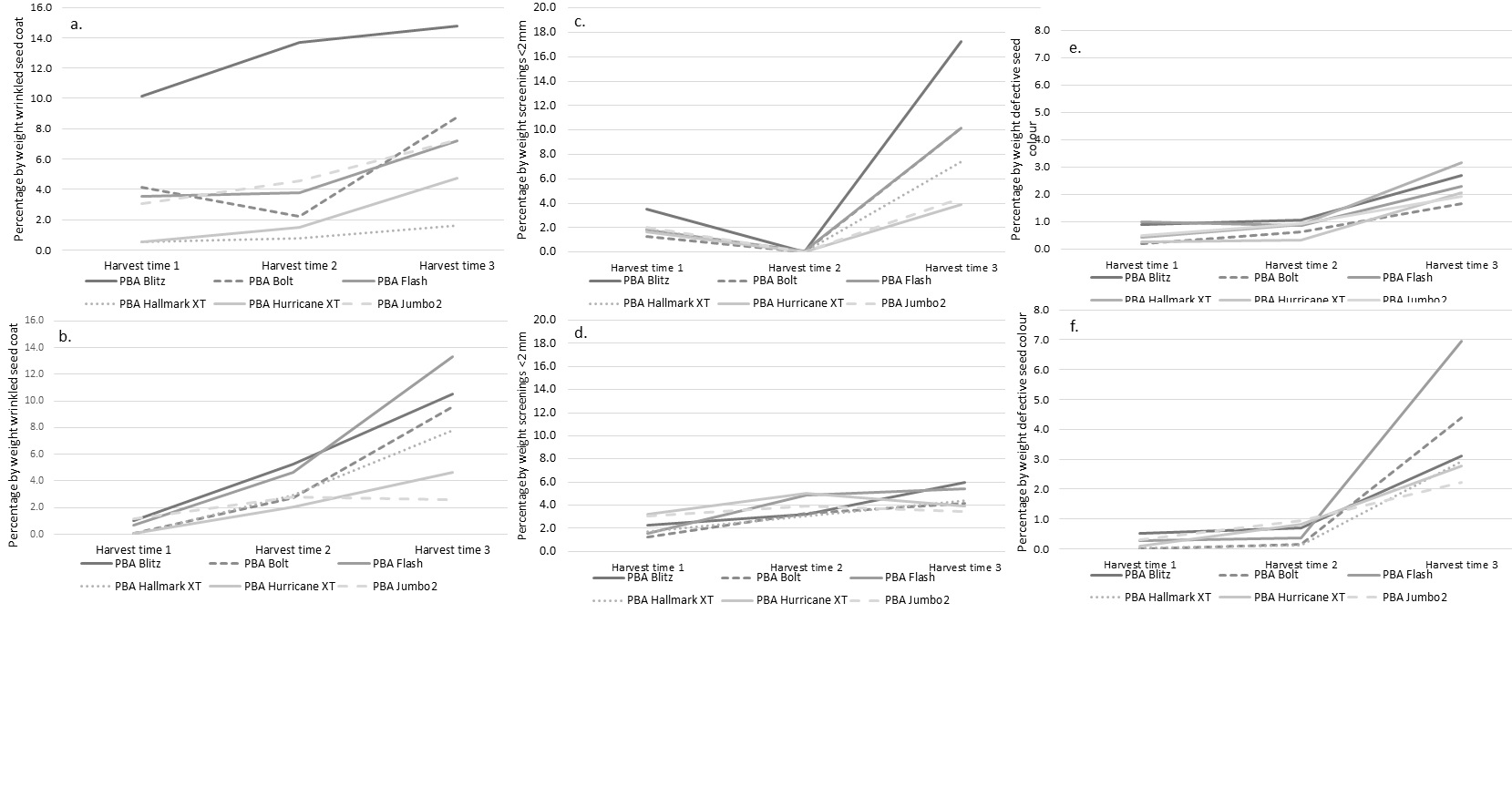
Figure 7. Grain quality, a. and b. wrinkling percentage, c. and d. screening percentage, e. and f. percentage seed colour response to delayed harvest timings at Melton 2016 (a, c, e) and Paskeville 2017 (b, d, f).
Conclusion
Lentil production from sowing to harvest is largely driven by paddock history and variety selection, which may be strongly influenced by the herbicide choices in the previous crop. Understanding the agronomic characteristics of the variety being grown will influence the subsequent management of weeds, disease, the opportunity to spray top, and harvest timing.
Useful resources
GRDC South Australian Crop Sowing Guide
National Variety Trials online
Acknowledgements
The research undertaken as part of three research projects is made possible by the significant contributions of growers through both trial cooperation and the support of the GRDC, the author would like to thank them for their continued support. The authors would like to acknowledge the support of the technical and support staff without whom much of this work would not be possible.
Contact details
Penny Roberts
SARDI
155 Main North Road, Clare SA 5453
0436 678 982
Penny.Roberts@sa.gov.au
GRDC Project Code: DAV1706-003RMX, UOA1702-019WSX, UOA1703-022BLX,
Was this page helpful?
YOUR FEEDBACK
